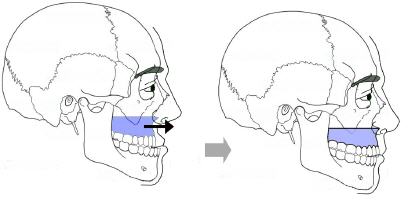Maxillary osteotomy surgery corrects upper jaw malposition. During the procedure, the surgeon makes an incision in the gums above the teeth in the upper jaw. The surgeon moves the upper jaw into the correct position. Then, he attaches a small plastic wafer to the teeth to help align the upper jaw in the perfect position. The jaw is fixed in place with titanium screws and metal plates.
Dental occlusion abnormalities have short, medium and long term consequences that should be known as these sometimes justify the surgical intervention. Dental alignment abnormalities can lead to:
- Significant risk of teeth loss.
- Issues in the jaw joints (temporomandibular) with pain, crunches, clicks or muscle contractions.
- Discomfort while eating or speaking.
- A significant aesthetic defect.
- Difficulty or even impossibility of fitting a prosthesis (dentures).
Generally, the osteotomy is associated with an orthodontic treatment carried out before and continued after the intervention (generally 3 to 6 months) in agreement with the orthodontist.
There are several types of maxillary surgery procedures:
- Inter-maxillary disjunction which aim is to widen the palate.
- L’avancée Maxillaire a pour but de corriger l’occlusion.
- Maxillary impaction which aim is to close an open bite ( a gap) or remove the "gummy smile".

Hospitalization
One night
Anesthesia
General
Duration
1 to 2 hours
Edema and bruising
5 to 10 days
Result
Significant improvement visible at day 21, final appearance at 3 months post-op


